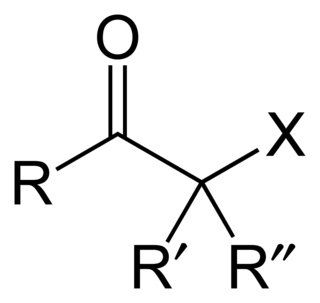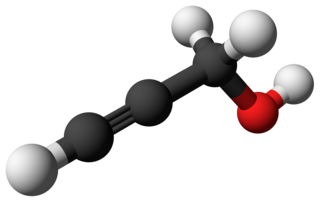Propyl chloride may refer to:
- 2-Chloropropane (isopropyl chloride)
- 1-Chloropropane (n-propyl chloride)
Propyl chloride may refer to:

An acyl group is a moiety derived by the removal of one or more hydroxyl groups from an oxoacid, including inorganic acids. It contains a double-bonded oxygen atom and an alkyl group (R-C=O). In organic chemistry, the acyl group is usually derived from a carboxylic acid, in which case it has the formula RCO–, where R represents an alkyl group that is linked to the carbon atom of the group by a single bond. Although the term is almost always applied to organic compounds, acyl groups can in principle be derived from other types of acids such as sulfonic acids and phosphonic acids. In the most common arrangement, acyl groups are attached to a larger molecular fragment, in which case the carbon and oxygen atoms are linked by a double bond.

Allyl chloride is the organic compound with the formula CH2=CHCH2Cl. This colorless liquid is insoluble in water but soluble in common organic solvents. It is mainly converted to epichlorohydrin, used in the production of plastics. It is a chlorinated derivative of propylene. It is an alkylating agent, which makes it both useful and hazardous to handle.

Hydrogen bromide is the inorganic compound with the formula HBr. It is a hydrogen halide consisting of hydrogen and bromine. A colorless gas, it dissolves in water, forming hydrobromic acid, which is saturated at 68.85% HBr by weight at room temperature. Aqueous solutions that are 47.6% HBr by mass form a constant-boiling azeotrope mixture that boils at 124.3 °C. Boiling less concentrated solutions releases H2O until the constant-boiling mixture composition is reached.
PolyAPTAC, or poly , is an organic polymer. It is water-soluble, forms gels when cross linked, and acts as a cationic polyelectrolyte. It can be used for ion exchange resins. It can form hydrogels.

Propan-1-ol is a primary alcohol with the formula CH3CH2CH2OH and sometimes represented as PrOH or n-PrOH. It is a colorless liquid and an isomer of 2-propanol. It is formed naturally in small amounts during many fermentation processes and used as a solvent in the pharmaceutical industry, mainly for resins and cellulose esters, and, sometimes, as a disinfecting agent.

In organic chemistry, an α-haloketone is a functional group consisting of a ketone group or more generally a carbonyl group with an α-halogen substituent. α-haloketones are alkylating agents. Prominent α-haloketones include phenacyl bromide and chloroacetone.

Lincomycin is a lincosamide antibiotic that comes from the actinomycete Streptomyces lincolnensis. A related compound, clindamycin, is derived from lincomycin by using thionyl chloride to replace the 7-hydroxy group with a chlorine atom with inversion of chirality. It was released for medical use in September 1964.

Propylamine, also known as n-propylamine, is an amine with the chemical formula CH3(CH2)2NH2. It is a colorless volatile liquid.
Dehydrohalogenation is an elimination reaction that eliminates (removes) a hydrogen halide from a substrate. The reaction is usually associated with the synthesis of alkenes, but it has wider applications.

Propargyl alcohol, or 2-propyn-1-ol, is an organic compound with the formula C3H4O. It is the simplest stable alcohol containing an alkyne functional group. Propargyl alcohol is a colorless viscous liquid that is miscible with water and most polar organic solvents.
Guar hydroxypropyltrimonium chloride is an organic compound that is a water-soluble quaternary ammonium derivative of guar gum. It gives conditioning properties to shampoos and after-shampoo hair care products. The effects of the cationic charge density, guar concentration in aqueous solution, and treatment time on bleached European hair have been studied. A mechanical testing method has been successfully applied to determine the efficacy of cationic guars to improve the ease of combing. The results were confirmed in a shampoo formulation on both virgin and bleached hair.

n-Propyl chloride (also 1-propyl chloride or 1-chloropropane) is a colorless, flammable chemical compound. It has the chemical formula C3H7Cl and is prepared by reacting n-propyl alcohol with phosphorus trichloride in the presence of a zinc chloride catalyst.
Chloropropane may refer to:

Bisulepin is strong and relatively selective antihistamine (H1 antagonist) with hypnotic, antiadrenergic and very weak anticholinergic and antiserotonergic effects. Bisulepin is marketed in the Czech Republic and Slovakia under the trademark Dithiaden as tablets and injections.

Bis(triethoxysilylpropyl)tetrasulfide is an organosulfur compound with the formula S4[C3H6Si(OEt)3]2 (Et = C2H5). The molecule consists of two trialkoxysilyl propyl groups linked with a polysulfide. It is often sold as a mixture with the trisulfide. The compound is a colorless viscous liquid that is soluble in ordinary organic solvents such as toluene. Commercial samples often are yellowish. The compound is added to rubber compositions that contain silica filler.
Chloropropanols are chlorohydrins related to propanols containing chloride functional group. Eight isomers are possible. Two of these derivatives, 1,3-dichloropropanol (1,3-DCP) and 3-chloropropane-1,2-diol (3-MCPD), are carcinogenic contaminants in processed foods. Several isomers are encountered in industrial chemistry.
The International Union of Pure and Applied Chemistry (IUPAC) has published four sets of rules to standardize chemical nomenclature.
Dimethyloctadecyl(3-trimethoxysilylpropyl)ammonium chloride (DTSACl) is a disinfectant used as a preservative and fungicide. Its chemical formula is C26H58NO3SiCl. It is also used as a silane coupling agent.
The molecular formula C3H7Cl (molar mass: 78.541 g/mol) may refer to:
1-Bromo-3-chloropropane is an organohalogen compound with the formula Br(CH2)3Cl. It is a colorless liquid, produced by free-radical addition of hydrogen bromide to allyl chloride. It is used as an alkylating agent to install the –(CH2)3Cl and –(CH2)3– groups. For example, it is a precursor to 4-chlorobutyronitrile.